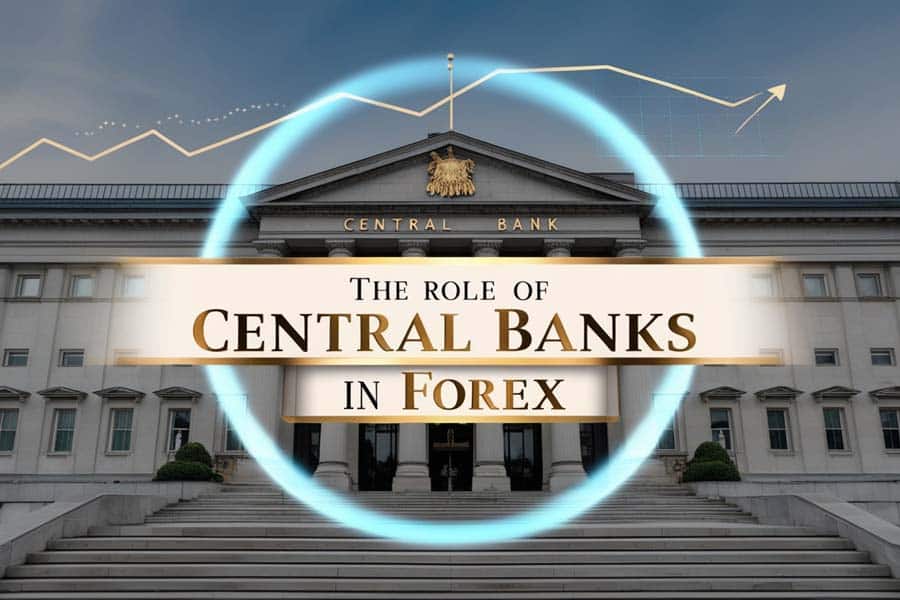What causes currencies to fluctuate in the forex market, and why do some currencies experience sudden value shifts? The answer often lies in the actions of central banks. Understanding the Role of Central Bank in Forex Trading is crucial for traders, as these financial institutions wield significant power over currency values. Central banks are responsible for setting monetary policies, adjusting interest rates, managing foreign exchange reserves, and intervening in the forex market to maintain stability. Each of these actions can lead to substantial movements in currency prices, presenting both opportunities and risks for forex traders.

In this comprehensive guide, we’ll explore the Role of Central Bank in Forex Trading, detailing their core functions, the tools they use, and how their interventions impact forex markets. For traders working with a regulated forex broker, insights into central bank activities can make a meaningful difference, enabling them to predict market trends and refine their strategies. Let’s dive deeper into how central banks shape the forex market and how traders can capitalize on this understanding.
What is the Role of Central Bank in Forex Trading?
Central banks are financial institutions tasked with managing a nation’s currency, controlling inflation, and promoting economic stability. They influence the forex market by setting interest rates, intervening in currency markets, and adopting policies to foster sustainable economic growth. The Role of Central Bank in Forex Trading is multifaceted, and traders who grasp these dynamics can make more informed trading decisions.

Exploring how central banks shape forex trading through policy and intervention.
Why Monitoring Central Bank Actions is Vital for Traders
Central bank decisions have direct and powerful effects on currency values. For instance, an interest rate hike by a central bank often strengthens a currency by attracting foreign investment, whereas a rate cut can weaken it. By tracking central bank actions, forex traders gain insights into likely currency movements, allowing them to position themselves strategically. Understanding the Role of Central Bank in Forex Trading not only enhances a trader’s ability to anticipate market trends but also empowers them to capitalize on these shifts.
Central Bank Functions Relevant to Forex Trading

Essential functions of central banks and their impact on global currency values.
Read More: Forex Trading Costs
1. Implementing Monetary Policy
Monetary policy is a cornerstone of the Role of Central Bank in Forex Trading. Central banks adjust interest rates and money supply to control inflation and stabilize the economy, which in turn influences currency value.
- Interest Rate Adjustments: Interest rate changes are among the most impactful tools for forex markets. Raising rates generally strengthens a currency by increasing returns on investments, attracting foreign capital. Lowering rates has the opposite effect, often weakening a currency. For forex traders, monitoring interest rate announcements is essential, as they frequently signal upcoming shifts in currency value.
- Inflation Control: Central banks aim to maintain low inflation to preserve purchasing power and economic stability. When inflation rises, a central bank may raise interest rates to curb it, affecting currency strength. For traders, tracking inflation rates can provide clues about future central bank actions, helping them understand the Central Bank Influence on Forex Market.
2. Managing Foreign Exchange Reserves
Foreign exchange reserves, held in various currencies, provide stability and liquidity during economic uncertainties. Managing these reserves is a critical component of the Role of Central Bank in Forex Trading.
- Currency Stabilization: Central banks can stabilize their currency by buying or selling foreign exchange reserves. For example:
- Buying Foreign Reserves: This action strengthens the domestic currency by reducing its availability in the forex market.
- Selling Foreign Reserves: This weakens the domestic currency by increasing its availability, making it less attractive.
Forex traders closely watch central bank reserve data, as significant reserve activities often signal impending central bank interventions that impact currency values.
3. Regulating Exchange Rate Policies
Exchange rate policy is another fundamental aspect of the Role of Central Bank in Forex Trading. Central banks may adopt different exchange rate regimes based on economic conditions and objectives.
- Floating Exchange Rate: Under this regime, the currency value is determined by the market without central bank intervention. For example, the U.S. dollar operates under a floating rate, with its value driven by supply and demand.
- Fixed or Pegged Exchange Rate: Some currencies are pegged to a stable currency (e.g., the USD) to maintain consistent value. This setup requires frequent central bank interventions to maintain the peg, ensuring stability in volatile conditions.
- Managed Float: In this regime, central banks allow the currency to float but intervene periodically to stabilize extreme fluctuations. For forex traders, understanding a central bank’s exchange rate policy is essential to anticipate potential Central Bank Interventions in Currency Markets.
4. Market Interventions
Direct market interventions occur when central banks actively buy or sell their currency to influence its value. These interventions are an essential aspect of the Role of Central Bank in Forex Trading, as they aim to stabilize currency markets during economic crises.
- Direct Interventions: By purchasing or selling large amounts of currency, central banks can stabilize or adjust currency values. Selling currency in large quantities may decrease its value, benefiting exports by making them more competitive.
- Indirect Interventions: Indirect actions, such as policy adjustments or public statements, influence market sentiment. These interventions may not directly involve currency transactions but can significantly impact forex markets.
Forex traders should remain aware of potential interventions, as they often lead to rapid currency value shifts, presenting both risks and opportunities.
Tools and Mechanisms Used by Central Banks

Understanding the powerful tools central banks use to influence forex markets.
Central banks employ a variety of tools to manage their economies and stabilize currency markets. Understanding these tools is critical for comprehending the Role of Central Bank in Forex Trading.
Read More: Forex Trading Tools
1. Interest Rate Adjustments
Interest rate changes impact forex markets by attracting or repelling investment based on the returns offered by a currency. Higher rates make a currency attractive, while lower rates often lead to a weaker currency.
- Investment Flows: Higher rates typically attract foreign investments, strengthening the currency. Lower rates reduce currency demand as investors look for better returns.
- Inflation Control: By adjusting rates, central banks influence inflation, which affects the purchasing power and value of a currency.
2. Open Market Operations (OMOs)
Open Market Operations involve buying or selling government securities to control the money supply and influence currency value.
- Increasing Money Supply: When central banks buy securities, they inject liquidity into the economy, which can depreciate the currency.
- Reducing Money Supply: Selling securities decreases money supply, potentially strengthening the currency. OMOs offer traders insights into central bank goals, enhancing their understanding of Central Bank Policies and Forex Trading.
3. Quantitative Easing (QE)
Quantitative Easing (QE) is a strategy where central banks purchase assets to increase money supply, often during periods of low inflation or economic crisis.
- Currency Depreciation: QE typically weakens a currency as it increases money supply, making it less valuable. Forex traders monitor QE announcements to anticipate currency trends.
- Market Impact: QE affects investor sentiment, creating opportunities for traders to adjust their strategies based on expected currency value shifts.
4. Forward Guidance
Forward guidance is a communication tool used by central banks to signal future policy intentions, helping set market expectations.
- Market Sentiment and Strategy: Forward guidance helps stabilize markets by preparing them for upcoming actions, making it an important tool for traders to anticipate currency value changes and build strategic trades.
Case Studies of Central Bank Influence on Forex Market

Real-world examples of how central banks impact the forex market.
Examining specific central bank actions provides deeper insights into the Role of Central Bank in Forex Trading.
Federal Reserve (U.S.)
The Federal Reserve’s interest rate hikes often strengthen the USD, influencing global forex markets. Traders in USD pairs like EUR/USD or GBP/USD closely monitor Fed announcements to adjust their strategies.
European Central Bank (ECB)
ECB policies, especially during economic crises, impact the Euro’s value. For instance, when the ECB implements QE or lowers interest rates, the Euro typically weakens, creating opportunities for traders.
Bank of Japan (BOJ)
The BOJ frequently intervenes to manage the Yen’s value, particularly during periods of low growth. Traders should follow BOJ policies closely to anticipate changes in JPY pairs.
Swiss National Bank (SNB)
The SNB prevents excessive appreciation of the Swiss Franc, as a strong Franc can harm Switzerland’s export-driven economy. Traders often look for signs of SNB interventions to anticipate volatility in Franc-based trades.
Practical Implications of Central Bank Influence for Forex Traders

How central bank decisions create both opportunities and challenges for forex traders.
Central bank actions profoundly affect the forex market, presenting both opportunities and challenges for traders. By understanding the Role of Central Bank in Forex Trading, traders can better navigate the volatility and trends that follow central bank decisions. Here are some practical strategies and tips for integrating central bank insights into your forex trading approach:
1. Stay Informed on Central Bank Announcements
Regularly tracking central bank announcements is essential for anticipating currency movements. Interest rate decisions, monetary policy updates, and economic forecasts from central banks provide critical information on future market conditions.
- Use Economic Calendars: Economic calendars are invaluable tools that highlight scheduled announcements from major central banks, such as the Federal Reserve, European Central Bank (ECB), and Bank of Japan (BOJ). This helps traders prepare in advance for potential market volatility.
- Real-Time Alerts: Many trading platforms and forex brokers, including OpoFinance, offer real-time alerts and updates for central bank announcements, ensuring you’re always aware of any major policy shifts that could impact your trades.
2. Analyze Interest Rate Decisions and Expectations
Interest rate changes are among the most significant drivers of currency value. Central banks adjust interest rates to control inflation and stabilize their economies, directly affecting the demand for a currency.
- Preemptive Rate Analysis: By analyzing economic indicators like inflation, GDP growth, and employment data, traders can anticipate potential interest rate changes. For example, rising inflation may signal an upcoming rate hike, which can strengthen the currency.
- Target Rate-Sensitive Currency Pairs: Certain currency pairs, like USD/JPY, EUR/USD, and GBP/USD, are especially sensitive to interest rate changes. Traders focusing on these pairs can align their strategies with anticipated rate movements, positioning themselves advantageously.
3. Develop Strategies Based on Central Bank Policy Bias
Each central bank has a policy bias based on its economic goals—whether to stimulate growth or control inflation. For instance, the Federal Reserve may adopt a “hawkish” stance (favoring higher interest rates) to control inflation, while the Bank of Japan might be more “dovish” (favoring low rates) to stimulate economic growth.
- Trading on Hawkish vs. Dovish Signals: Hawkish policies usually strengthen a currency, while dovish policies can weaken it. Traders can look for these signals in central bank statements, minutes, and forward guidance to anticipate the direction of currency trends.
- Identify Long-Term Trends: Central bank biases influence long-term trends in forex markets. For instance, a central bank’s commitment to raising rates over several quarters may set a bullish trend for that currency. Recognizing these trends allows traders to set longer-term positions and take advantage of policy-driven currency appreciation or depreciation.
4. Adapt to Market Interventions and Currency Stabilization Efforts
Direct interventions by central banks in forex markets can lead to sudden currency value changes. Central banks may intervene to stabilize or control currency levels during times of excessive volatility or economic crisis.
- Monitor Reserve Data: Changes in foreign exchange reserves can indicate an upcoming intervention. For instance, if a central bank increases its foreign currency reserves, it may be preparing to strengthen or stabilize its currency.
- Prepare for Volatility: Market interventions often lead to sharp, sudden movements. Traders should be prepared with strategies to manage potential volatility, such as setting stop-loss orders or taking smaller position sizes to reduce risk during uncertain periods.
5. Incorporate Sentiment Analysis for Real-Time Market Reactions
Sentiment analysis helps traders gauge the market’s immediate response to central bank announcements. By understanding the prevailing sentiment, traders can better anticipate short-term price movements.
- Track Market Sentiment Tools: Many platforms offer sentiment analysis tools that reveal the percentage of traders buying or selling a currency following central bank news. This data provides insight into broader market reactions, helping traders decide whether to go with or against the trend.
- Use Sentiment to Confirm Trading Decisions: Combining sentiment data with technical and fundamental analysis can provide a more comprehensive view. For example, if sentiment analysis shows a majority bullish stance after a rate hike, it may confirm a trader’s decision to take a long position on that currency.
By applying these strategies, traders can harness central bank insights to make more informed, precise trading decisions. Recognizing and adapting to the Role of Central Bank in Forex Trading allows traders to approach the market strategically, enhancing their ability to capitalize on economic shifts while managing risks effectively.
Read More: Forex Rollover Rates
OpoFinance Services: A Regulated Broker for Secure Forex Trading
OpoFinance, an ASIC-regulated broker, offers a stable and secure platform for traders navigating the Role of Central Bank in Forex Trading. Here’s why OpoFinance is a reliable choice:
- ASIC Regulation: OpoFinance’s regulatory compliance ensures that funds are protected and the platform operates transparently, offering a secure trading environment.
- Social Trading: OpoFinance provides a social trading feature, enabling traders to learn from experienced investors. This is particularly valuable during central bank-driven market shifts.
- MT5 Platform Access: As an official MT5 broker, OpoFinance provides advanced tools for real-time analysis, automation, and trading strategy development, essential for trading based on central bank data.
- Flexible Transactions: With secure deposit and withdrawal options, OpoFinance makes it easy for traders to manage funds efficiently, allowing them to act swiftly when market conditions change due to central bank activities.

Choosing OpoFinance means traders can access tools that enhance their ability to interpret Central Bank Policies and Forex Trading with greater accuracy.
Conclusion
The Role of Central Bank in Forex Trading is profound, shaping currency markets through carefully crafted policies, interest rate decisions, and direct interventions. Central banks act as the guardians of economic stability, aiming to control inflation, stabilize currencies, and foster economic growth. For forex traders, understanding these actions is essential for making informed decisions and aligning trading strategies with market realities.
Each central bank decision—whether an interest rate hike, reserve adjustment, or policy shift—can influence currency values significantly, creating ripple effects across the forex market. By keeping a close watch on central bank announcements and economic indicators, traders gain the ability to anticipate potential currency trends, identify opportunities, and mitigate risks associated with central bank actions. This strategic awareness empowers traders to react to market conditions swiftly, positioning themselves advantageously in a constantly evolving forex landscape.
Partnering with a regulated forex broker like OpoFinance enhances this approach by providing access to real-time data, market insights, and tools tailored to navigating central bank influences. OpoFinance’s secure platform, complete with social trading options and an MT5 interface, offers a comprehensive trading environment designed for both novice and seasoned traders. Social trading allows less experienced traders to follow and learn from seasoned investors, particularly useful during times of central bank-driven volatility. The platform’s regulatory status ensures that traders can focus on strategy and decision-making, knowing their funds are protected.
In a world where central bank decisions can instantly change the course of currency values, staying informed and responsive is key. Traders who prioritize understanding the Role of Central Bank in Forex Trading are better equipped to make decisions that align with market trends and economic conditions. By blending central bank insights with disciplined strategies and reliable tools from a broker like OpoFinance, traders can approach the forex market with confidence and precision.
For forex traders, the journey to success is continuous learning, especially in understanding central bank influences. With the right knowledge, tools, and partners, traders can turn these insights into profitable opportunities. Embracing a proactive, informed approach to trading—one that incorporates central bank trends and economic indicators—is the key to navigating and succeeding in today’s dynamic forex markets.
Key Takeaways
- Central banks affect forex markets by setting interest rates, intervening in currency markets, and implementing policy changes.
- Forex traders should track central bank announcements to anticipate currency trends and refine trading strategies.
- OpoFinance offers a secure platform with advanced trading tools, ideal for those trading in central bank-influenced markets.
How often do central banks change interest rates, and how does this impact forex?
Central banks typically review interest rates quarterly, but adjustments depend on economic conditions. Rate hikes generally strengthen a currency by attracting foreign investment, while rate cuts can weaken it. Forex traders should monitor these changes closely, as they significantly impact currency value.
What are foreign exchange reserves, and why do central banks use them in forex trading?
Foreign exchange reserves are assets held by central banks in foreign currencies. Central banks use them to stabilize their currency during economic fluctuations by buying or selling reserves, directly influencing currency value and maintaining liquidity.
How can a forex broker help traders understand central bank influences?
A regulated forex broker like OpoFinance offers tools, insights, and market analysis that help traders interpret central bank actions, making it easier to adjust trading strategies based on policy changes.







